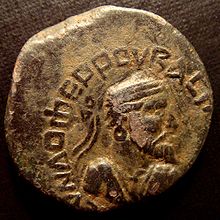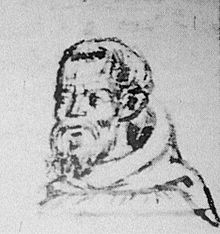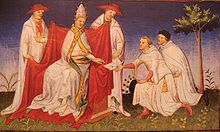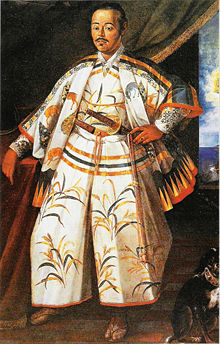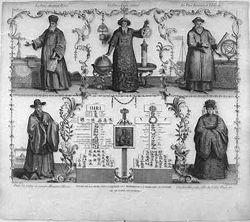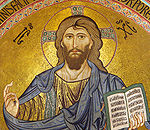- Christianity in Asia
-
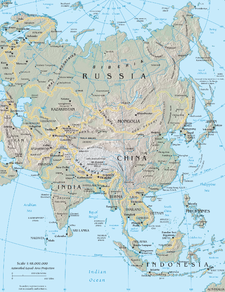 Christianity spread from Western Asia to China between the 1st to the 14th century AD, and further to Eastern Asia from the 16th century with the European Age of Discovery.
Christianity spread from Western Asia to China between the 1st to the 14th century AD, and further to Eastern Asia from the 16th century with the European Age of Discovery.
Christianity in Asia has its roots in the very inception of Christianity, which originated from the teachings of Jesus Christ. Christianity in Asia then spread through the missionary work of his apostles. Christianity first expanded in the Levant, taking roots in the major cities such as Jerusalem and Antioch. According to tradition, further eastward expansion occurred via the preaching of Saint Thomas the Apostle, who established Christianity in the Parthian Empire (Iran) and India. The first Asian nations to adopt Christianity as a state religion were Armenia in 301 and Georgia in 327.
After the First Council of Ephesus in 431 and the Nestorian Schism, Christianity split into the Western (Roman) versions, and the Eastern or Nestorian Christianity, though the term Nestorian was sometimes used as a catchall phrase to refer to several different Eastern doctrines. Nestorians began converting Mongols around the 7th century, and Nestorian Christianity was probably introduced into China during the Tang Dynasty (618-907). Mongols tended to be tolerant of multiple religions, with several Mongol tribes being primarily Christian, and under the leadership of Genghis Khan's grandson, the great khan Mongke, Christianity was a small religious influence of the Mongol Empire in the 13th century.
Around that same time, there was some effort to reunite Eastern and Western Christianity. There were also numerous missionary efforts from Europe to Asia, primarily by Franciscan, Dominican, or Jesuit missionaries. In the 16th century, Spain began to convert Filipinos. In the 18th century, Catholicism developed more or less independently in Korea. In modern times, Christianity continues to be the predominant faith in Armenia, Georgia, Russia, the Philippines, and East Timor, with significant minorities in South Korea, Lebanon, Syria, Kazakhstan and several other countries in Asia.
Contents
Early spread in Asia
See also: History of Eastern Christianity in AsiaWestern Asia
Levant
Christianity spread through the Levant (Eastern Mediterranean) from the 1st century AD. One of the key centers of Christianity became the city of Antioch, previous capital of the Hellenistic Seleucid Empire, located in today what is modern Turkey. Antioch was evangelized perhaps by Peter the Apostle, according to the tradition upon which the Antiochene patriarchate still rests its claim for primacy,[1] and certainly by Barnabas and Paul. Its converts were the first to be called Christians.[2] They multiplied rapidly, and by the time of Theodosius (347–395) were reckoned by Chrysostom (347–407), Archbishop of Constantinople, at about 100,000 people. Between 252 and 300, ten assemblies of the church were held at Antioch and it became the seat of one of the original five patriarchates, along with Jerusalem, Alexandria, Constantinople, and Rome.
Caucasus

Armenia and Georgia were the first nations to adopt Christianity as a state religion, in 301 and 327 respectively.
Christianity had been preached in Armenia by two of Jesus' twelve apostles — Thaddaeus and Bartholomew — between 40-60 AD. Because of these two founding apostles, the official name of the Armenian Church is Armenian Apostolic Church, and it is considered to be the world's oldest national church. The Church of Caucasian Albania was established in 313, after Caucasian Albania (located in what is now Azerbaijan) became a Christian state.
In Georgia, Christianity was first preached by the apostles Simon and Andrew in the first century. It became the state religion of Kartli, Iberia (the area of Georgia's capital) in 327. The conversion of Georgia to Christianity is credited to the efforts of Saint Nino of Cappadocia (290–338).[3]
Parthian Empire
Main article: Christianity in IranChristianity further spread eastward under the Parthian Empire, which displayed a high tolerance of religious matters.[4] According to tradition, Christian proselytism in Central Asia, starting with Mesopotamia and the Iranian plateau, was put under the responsibility of Saint Thomas the Apostle, and started in the first century AD.[5] Saint Thomas is also credited with the establishment of Christianity in India. The Christians of Mesopotamia and Iran were organized under several bishops, and were present at the First Council of Nicaea in 325 AD.[5]
Expansion to Central Asia
The spread of Christianity in Central Asia seems to have been facilitated by the great diffusion of Greek in the region (Seleucid Empire, Greco-Bactrian Kingdom, Indo-Greek Kingdom), as well as Aramaic, the language of Jesus Christ. The spread of the Jews in Asia since the deportation from Babylon and the capture of Jerusalem by Titus also seems to have been a contributing factor.[5]
The earliest known references to Christian communities in Central Asia is from a writing by Bar Daisan around 196 AD: "Nor do our sisters among the Gilanians and Bactrians have any intercourse with strangers".[6]
The Sasanians also proved rather tolerant of the Christian faith until the persecution by the Zoroastrian priest Kartir under Bahram II (276−93 AD). Further persecutions seem to have taken place under Shapur II (310-379) and Yazdegerd II (438-457), with events in 338 having brought significant damage to the faith.[5]
India (1st century AD)
According to tradition, the Indo-Parthian king Gondophares was proselytized by St Thomas, who continued on to southern India, and possibly as far as Malaysia or China.
According to Eusebius' record, the apostles Thomas and Bartholomew were assigned to Parthia (modern Iran) and India.[7][8] By the time of the establishment of the Second Persian Empire (AD 226), there were bishops of the Church of the East in northwest India, Afghanistan and Baluchistan (including parts of Iran, Afghanistan, and Pakistan), with laymen and clergy alike engaging in missionary activity.[7]
An early third-century Syriac work known as the Acts of Thomas[7] connects the apostle's Indian ministry with two kings, one in the north and the other in the south. According to the Acts, Thomas was at first reluctant to accept this mission, but the Lord appeared to him in a night vision and compelled him to accompany an Indian merchant, Abbanes (or Habban), to his native place in northwest India. There, Thomas found himself in the service of the Indo-Parthian King, Gondophares. The Apostle's ministry resulted in many conversions throughout the kingdom, including the king and his brother.[7]
Thomas thereafter went south to Kerala and baptized the Jewish settlers and a few natives, whose descendants form the Saint Thomas Christians or the Syrian Malabar Nasranis.[9]
Piecing together the various traditions, the story suggests that Thomas left northwest India when invasion threatened, and traveled by vessel to the Malabar Coast along the southwestern coast of the Indian continent, possibly visiting southeast Arabia and Socotra enroute, and landing at the former flourishing port of Muziris on an island near Cochin in 52. From there he preached the gospel throughout the Malabar Coast. The various Churches he founded were located mainly on the Periyar River and its tributaries and along the coast, where there were Jewish colonies. He preached to all classes of people and had about 170 converts, including members of the four principal castes. Later, stone crosses were erected at the places where churches were founded, and they became pilgrimage centres. In accordance with apostolic custom, Thomas ordained teachers and leaders or elders, who were reported to be the earliest ministry of the Malabar church.
Thomas next proceeded overland to the Coromandel Coast in southeastern India, and ministered in what is now the Madras area, where a local King and many people were converted. One tradition related that he went from there to China via Malacca in Malaysia, and after spending some time there, returned to the Madras area.[10] Apparently his renewed ministry outraged the Brahmins, who were fearful lest Christianity undermine their social caste system. So according to the Syriac version of the Acts of Thomas, Mazdai, the local king at Mylapore, after questioning the Apostle condemned him to death about the year AD 72. Anxious to avoid popular excitement, the King ordered Thomas conducted to a nearby mountain, where, after being allowed to pray, he was then stoned and stabbed to death with a lance wielded by an angry Brahmin.[7][9]
Expansion of Nestorian Christianity (431-1360 AD)
Main articles: History of Eastern Christianity in Asia and NestorianismIn 410 the Sassanid emperor summoned the Persian church leaders to the Synod of Seleucia. His purpose was to make the Catholicos of Seleucia-Ctesiphon the minority leader of the Christians in the Empire, and personally responsible for their good conduct throughout the Persian empire. The synod accepted the emperor's wish.
In 424 the bishops of Persia met in council under the leadership of Catholicos Dadiso and determined that there would be no reference of their disciplinary or theological problems to any other power, especially not to any church council in the Roman Empire. The formal separation from the See of Antioch and the western Syrian Church under the Roman (Byzantine) Emperors, occurred at this synod in 424.
Nestorianism
The eastern development of Christianity continued to separate from the west, pushed along by such events as 431's Council of Ephesus, in which the Syrian bishop Nestorius, Patriarch of Constantinople since 428, was accused of heresy for preaching his brand of Christianity, labelled Nestorianism after him. He and his followers were banished from the Byzantine Empire, and other religious and political institutions gave him sanctuary. Eastern Christianity seceded to form what is sometimes called the Church of the East, or Syro-Oriental Church,[11] though some historians refer to it with the catchall term Nestorian Church, even though many Eastern Christians were not following the doctrine preached by Nestorius.
Expansion to Sogdiana and eastern Central Asia
Proselytism, combined with sporadic Sassanian persecutions and the exiling of Christian communities in their own area, caused the spread of Christianity to the east.
The Edict of Milan in 313, granted Christianity toleration by the Roman Empire. After the Emperor Constantin's conversion to Christianity, the indigenous Christians of Persia were considered a political threat to the Sassanians. They exiled Christian communities to the east, such as a community of Orthodox Melchites who were installed in Romagyri near Tashkent, or a community of Jacobites, who were sent to Yarkand in the Xinjiang at the doorstep of China.[12] The Hephthalites are known to have been open somewhat to Christianity since 498, and they requested the Nestorian Catholicos to establish a diocesan bishop in their lands in 549.[13]
By 650, there were 20 Nestorian dioceses east of the Oxus river.[14] The development of Islam in the late 7th century further cut off Asian Christianity from the western Christians, but eastern expansion of the faith continued nonetheless. Relations with Islam were good enough for the Catholicos to leave Seleucia-Ctesiphon to set up his seat in Baghdad upon the establishment of the Abbassids in 750.
From the 7th century onward, the nomadic Turks of Central Asia started to convert to Nestorian Christianity. Mass conversions are recorded in 781−2 and later in 1007, when 200,000 Turks and Mongols reportedly became Christians.[15] The Turkish Kipchaks are also known to have converted to Christianity at the suggestion of the Georgians as they allied in their conflicts against the Muslims. A great number were baptized at the request of the Georgian king David II. From 1120, there was a Kipchak national Christian church and an influential clergy.[16]
Early Christianity in China
Main articles: Christianity in China and Church of the East in China The Nestorian Stele in China, erected in 781. The title is :大秦景教流行中國碑 "Stele of the propagation of the luminous Roman faith in China"
The Nestorian Stele in China, erected in 781. The title is :大秦景教流行中國碑 "Stele of the propagation of the luminous Roman faith in China"
Christianity may have existed earlier in China, but the first documented introduction was during the Tang Dynasty (618–907) A Christian mission under the leadership of the priest Alopen (described variously as Persian, Syriac, or Nestorian) was known to have arrived in 635, where he and his followers received an Imperial Edict allowing for the establishment of a church.[17] In China, the religion was known as Dàqín Jǐngjiào (大秦景教), or the Luminous Religion of the Romans. 大秦 Dàqín designates Rome and the Near East, though from the Western view, Nestorian Christianity was considered heretical by the Latin Christians.
Opposition arose to the Christians in 698-699 from the Buddhists, and then from the Daoists in 713, but Christianity continued to thrive, and in 781, a stone stele (the Nestorian Stele) was erected at the Tang capital of Chang-an, which recorded 150 years of Emperor-supported Christian history in China. The text of the stele describes flourishing communities of Christians throughout China, but beyond this and few other fragmentary records, relatively little is known of their history. In later years, other emperors were not as religiously tolerant. In 845, the Chinese authorities implemented an interdiction of foreign cults, and Christianity diminished in China until the time of the Mongol Empire in the 13th century.[17][18]
Christianity among the Mongols
Main article: Christianity among the MongolsOverall, Mongols were highly tolerant of most religions, and typically sponsored several at the same time. They had been proselytized by Nestorian Christians since about the 7th century,[19] and several Mongol tribes, such as the Kerait,[20] Naimans, Merkit, and to a large extent the Kara Khitan (who practiced it side-by-side with Buddhism),[21] were also Christian.[22]
The founder of the Mongol Empire, Genghis Khan (1162–1227) was a shamanist, but showed great tolerance to other religions.[23] His sons were married to Christian princesses of the Kerait clan,[23] such as Sorghaghtani Beki[24] and Doquz Khatan, a remarkable Kerait noblewoman, the granddaughter of Toghrul Khan and a passionate Christian who held considerable influence at the court of the Khan. She made no secret of her dislike of Islam and her eagerness to help Christians of every sect.[25]
Under the rule of Genghis's grandson Möngke Khan (1205–1259), son of Sorghaghtani, the main religious influence was that of the Christians, to whom Mongke showed especial favour in memory of his mother.[26]
East-West rapprochement
Following the 1054 East-West Schism, various efforts, over several centuries, were made at reuniting eastern and western Christianity, with the objective of putting both under the rule of the Pope.
Armenian Church
The Armenian king Hetoum II, as a Franciscan monk.
In 1198, a Union was proclaimed between Rome and the Armenian Church[disambiguation needed
 ] by the Armenian catholicos of Sis Grigor VI Apirat. This was not followed in deeds however, as the local clergy and populace was strongly opposed to such a union. Again in 1441, the Armenian Catholicos of Sis Grigor IX Musabekiants proclaimed the union of the Armenian and Latin churches at the Council of Florence, but this was countered by an Armenian schism under Kirakos I Virapetsi, which installed the Catholicos see at Edjmiatzin, and maginalized Sis.[27]
] by the Armenian catholicos of Sis Grigor VI Apirat. This was not followed in deeds however, as the local clergy and populace was strongly opposed to such a union. Again in 1441, the Armenian Catholicos of Sis Grigor IX Musabekiants proclaimed the union of the Armenian and Latin churches at the Council of Florence, but this was countered by an Armenian schism under Kirakos I Virapetsi, which installed the Catholicos see at Edjmiatzin, and maginalized Sis.[27]Numerous Roman Catholic missions were also sent to Cilician Armenia to help with rapprochement. The Franciscans were put in charge of these missions. William of Rubruck visited Cilicia in 1254, and John of Monte Corvino in 1288.[28] The Armenian king Hethoum II (1266–1307) would himself become a Franciscan monk upon his multiple abdications. Another such monk was the historian Nerses Balients, who was a member of the "Unitarian" movement advocating unification with the Latin Church.
Byzantine church
Various efforts were also made by the Byzantine Church to unite with Rome. In 1272, John of Montecorvino was commissioned by the Byzantine emperor Michael VIII Palaiologos to communicate with Pope Gregory X, to negotiate for the reunion of the Orthodox and Catholic Churches. The objective was to drive a wedge between the pope and supporters of the Latin Empire, who had views on reconquering Constantinople. A tenuous union between the Greek and Latin churches was signed at the Second Council of Lyons in 1274. Michael VIII's concession was met with determined opposition at home, and prisons filled with many opponents to the union. At the same time the unionist controversy helped drive Byzantium's Orthodox neighbors Serbia and Bulgaria into the camp of Michael VIII's opponents. For a while the diplomatic intent of the union worked out in the West, but in the end Pope Martin IV, an ally of Charles of Anjou, excommunicated Michael VIII.[citation needed]
Roman Catholic missions to China and the Mongols
Main article: Medieval Roman Catholic Missions in ChinaContacts between the Mongols and the West occurred in the 13th century, as the Mongol Empire expanded towards Europe and Palestine, coinciding with the latter part of the Crusades. Initial contacts showed that the Mongols had the impression that the Pope was the leader of the Europeans, and sent him messages insisting that he submit Europe to Mongol authority. In return, the Mongols stated that after they conquered Jerusalem, they would return it to the Crusaders. The various popes, for their part, seemed to be unaware that Christianity already existed in the East, and tended to respond with messages insisting that the Mongols convert to Christianity and accept baptism. Later communications between the Mongols and Europe saw attempts to form a Franco-Mongol alliance against the Muslims.
In 1253, King Louis IX sent the Franciscan William of Rubruck to the Mongol capital of Karakorum to convert the Tartars. William visited the court of the great khan Mongke in 1254, and observed representatives of several religions there. He engaged in a famous debate set up by Mongke, with representatives of each religion debating (unsuccessfully) which was best. He left in August 1254, bearing Mongke's reply to King Louis.[29][1]
In 1268, Marco Polo's father and uncle returned from China with an invitation from Kublai Khan to the pope, imploring him that a hundred teachers of science and religion be sent to reinforce the Christianity already present in Kublai's empire. However, this came to naught due to the hostility of influential Nestorian Christians within the largely Mongol court.[2] Kublai did request Western assistance to secure Mongol rule over the Chinese Yuan Dynasty. In 1289, Pope Nicholas IV sent the Franciscan John of Monte Corvino to China by way of India. Although Kublai had already died by the time John arrived in 1294, the court at Khanbaliq received him graciously and encouraged him to settle there. John was China’s first Roman Catholic missionary, and he was significantly successful. He laboured largely in the Mongol tongue, translated the New testament and Psalms, built a central church, and within a few years (by 1305) could report 6,000 baptized converts. He also established a lay training school of 150 students. Other priests joined him, John was consecrated a bishop, and centers were established in the coastal provinces of Kiangsu (Yangchow), Chekiang (Hangchow) and Fukien (Zaitun). Under John's influence, many Mongols, such as those of the Ongut tribe, changed allegiance from the Eastern Nestorian (Syro-Oriental) Church, to Western Roman Catholicism.[30]
Following the death of Monte Corvino, an embassy to the French Pope Benedict XII in Avignon was sent by Toghun Temür in 1336, requesting a new spiritual guide. The pope replied by appointing four ecclesiastics as his legates to the khan's court. In 1338, a total of 50 ecclesiastics were sent by the Pope to Peking, such as John of Marignolli, who arrived in Khanbaliq in 1342, and stayed until 1347, then returning to Avignon in 1353.[30]
However, the Mongol-established Yuan Dynasty in China was in decline, and in 1368 was overthrown by the Ming Dynasty founded by the native Chinese. The last Catholic bishop of Quanzhou, Giacomo da Firenze, was killed by the Chinese in 1362. By 1369 all Christians, whether Roman Catholic or Nestorian (Syriac Orthodox, or Syro-Oriental), were expelled.[30]
European voyages of exploration
The European voyages of exploration in the 16th century would create new opportunities for Christian proselytism.
Catholicism in the Philippines
At the end of the 16th century, Hasekura Tsunenaga led a mission to the Pope and was baptized a Christian. Main article: Christianity in the PhilippinesMain article: Roman Catholicism in the Philippines
Main article: Christianity in the PhilippinesMain article: Roman Catholicism in the PhilippinesMagellan's arrival in Cebu represents the first attempt by Spain to convert Filipinos to Roman Catholicism. The story goes that Magellan met with Chief Humabon of the island of Cebu, who had an ill grandson. Magellan (or one of his men) was able to cure or help this young boy, and in gratitude Chief Humabon allowed 800 of his followers to be 'baptized' Christian in a mass baptism. Later, Chief Lapu Lapu of Mactan Island killed Magellan and routed the ill-fated Spanish expedition. This resistance to Western intrusion makes this story an important part of the nationalist history of the Philippines. Many historians have claimed that the Philippines peacefully 'accepted' Spanish rule; the reality is that many insurgencies and rebellions continued on small scales in different places through the Hispanic colonial period.[citation needed]
After Magellan, the Spanish later sent the explorer Legaspi to the Philippines, and he conquered a Muslim Filipino settlement in Manila in 1570. Islam had been present in the southern Philippines since some time between the 10th and 12th century. It slowly spread north throughout the archipelago, particularly in coastal areas.
Jesuits in China
Main article: Jesuit China missionsThe missionary efforts and other work of the Society of Jesus, or Jesuits, between the 16th and 17th century played a significant role in continuing the transmission of knowledge, science, and culture between China and the West, and had an impact on Christian culture in Chinese society today. Members of the Jesuit delegation to China were perhaps the most influential of the different Christian missionaries in that country between the earliest period of the religion up until the 19th century, when significant numbers of Catholic and Protestant missions developed. Prominent Jesuit missionaries included the Spanish St. Francis Xavier, and the Italian Matteo Ricci. At the time of their peak influence, members of the Jesuit delegation were considered some of the emperor's most valued and trusted advisors, holding numerous prestigious posts in the imperial government. However, between the 18th and mid-19th century, nearly all Western missionaries in China were forced to conduct their teaching and other activities covertly.
Independently formed Catholic movements (Korea)
Main article: Roman Catholicism in South KoreaMain article: Christianity in Korea#Early_history:_1593-1784The history of Catholicism in Korea began in 1784 when Yi Sung-hun was baptized while in China under the Christian name of Peter. He later returned home with various religious texts and baptized many of his fellow countrymen. The Church in Korea survived without any formal missionary priests until clergy from France (the Paris Foreign Missions Society) arrived in 1836 for the ministry.[31]
During the 19th century, the Catholic Church suffered persecution by the government of the Joseon Dynasty, chiefly for the religion's refusal to carry out ancestral worship, which it perceived to be a form of idolatry, but which the State prescribed as a cornerstone of culture. A century-long persecution produced thousands of martyrs - 103 of whom were canonized by Pope John Paul II in May 1984, including the first Korean priest, St. Andrew Dae-gun Kim, who was ordained in 1845 and martyred in 1846. Despite the persecution though, the Church in Korea expanded. The Apostolic Vicariate of Korea was formed in 1831, and after the expansion of Church structure for next century, the current structure of three Metropolitan Provinces each with an Archdiocese and several suffragan Dioceses was established in 1962.
Currently Deokwon (덕원) in North Korea is the See of the only territorial abbey outside Europe. The abbey was vacant for more than 50 years until Fr. Francis Ri was appointed as abbot in 2005. The abbey was never united with or changed into a diocese presumably due to the lack of effective church activity in the area since the division of Korea at the end of World War II.
Christianity in Asia today
Today, Christianity is the predominant faith in four Asian countries, the Philippines, East Timor, Armenia, Georgia and also in one other that is partially in Asia: i.e. Russia. In South Korea, while the largest proportion of the population is irreligious, Christianity represents the most widespread religion, closely followed by Buddhism.
Christianity exists as a minority faith in most other Asian countries, the most significant minorities being found in Lebanon, Israel, India, Iraq, Jordan, Syria, Kazakhstan and Indonesia. Small Christian communities are present in the China, Taiwan, Japan, Singapore, Vietnam, Uzbekistan, Sri Lanka and Malaysia.
Notes
Christianity by Country
AsiaNorth AmericaSouth AmericaOceania- ^ cf. Acts xi.
- ^ Acts 11:26
- ^ http://stnina.ca/stnina_life.html
- ^ Richard Foltz, Religions of the Silk Road, Palgrave Macmillan, 2nd edition, 2010, p. 65 ISBN 978-0-230-62125-1
- ^ a b c d Roux, L'Asie Centrale, p.216
- ^ Foltz, Religions of the Silk Road
- ^ a b c d e A.E. Medlycott, India and The Apostle Thomas, pp.18-71 M.R. James, Apocryphal New Testament, pp.364-436 A.E. Medlycott, India and The Apostle Thomas, pp.1-17, 213-97 Eusebius, History, chapter 4:30 J.N. Farquhar, The Apostle Thomas in North India, chapter 4:30 V.A. Smith, Early History of India, p.235 L.W. Brown, The Indian Christians of St. Thomas, p.49-59
- ^ http://www.stthoma.com/
- ^ a b James, M. R. (1966) "The Acts of Thomas" in The Apocryphal New Testament, pp. 365−77; 434−8. Oxford.
- ^ Breviary of the Mar Thoma Church in Malabar
- ^ Uhalley, p. 15
- ^ Roux, L'Asie Centrale, p.217
- ^ Roux, L'Asie Centrale, p.218
- ^ Foltz, p. 68
- ^ Foltz, p. 70
- ^ Roux, L'Asie Centrale, p.242
- ^ a b Roux, p.220
- ^ Uhalley, p. 14
- ^ "The Silk Road", Frances Wood, p. 118
- ^ Runciman, p. 238
- ^ Grousset, Empire, p. 165
- ^ "Les Croisades, origines et conséquences", p. 74
- ^ a b Runciman, p.246
- ^ "Sorghaqtani, a Kerait by birth and, like all her race, a devout Nestorian Christian", Runciman, p. 293
- ^ Runciman, p. 299
- ^ Runciman, p. 296
- ^ Mahé, p.71-72
- ^ Luisetto, p.98
- ^ Grousset, Empire, pp. 280-281
- ^ a b c Uhalley, pp. 14-16
- ^ The Liturgy of the Hours Supplement (New York: Catholic Book Publishing Co., 1992), pp. 17-18.
References
- Encyclopedia Iranica, Article on Franco-Persian relations
- "The Monks of Kublai Khan Emperor of China", Sir E. A. Wallis Budge.
- "The history and Life of Rabban Bar Sauma", translated from the Syriac by Sir E. A. Wallis Budge
- Foltz, Richard, Religions of the Silk Road, Palgrave Macmillan, 2nd edition, 2010 ISBN 978-0-230-62125-1
- "Histoire des Croisades III, 1188−1291", Rene Grousset, editions Perrin, ISBN 226202569
- Grousset, René (translator, Naomi Walford) (1970). The Empire of the Steppes. New Brunswick: Rutgers University Press. ISBN 978-0-813-51304-1. OCLC 90972.
- Jackson, Peter (2005). The Mongols and the West: 1221-1410. Longman. ISBN 978-0582368965
- Weatherford, Jack (2004). Genghis Khan and the Making of the Modern World. Three Rivers Press. ISBN 0-609-80964-4.
- Roux, Jean-Paul (1997), L'Asie Centrale, Histoire et Civilization, Librairie Arthème-Fayard, ISBN 9782213598949
- Luisetto, Frédéric, "Arméniens et autres Chrétiens d'Orient sous la domination Mongole", Geuthner, 2007, ISBN 9782705337919
- Mahé, Jean-Pierre, "L'Arménie à l'épreuve des siècles", Decouvertes Gallimard, 2005, ISBN 9782070314096
- Uhalley, Stephen; Wu, Xiaoxin (2001). China and Christianity: burdened past, hopeful future. M.E. Sharpe. ISBN 9780765606617.
Christianity in Asia Sovereign
states- Afghanistan
- Armenia
- Azerbaijan
- Bahrain
- Bangladesh
- Bhutan
- Brunei
- Burma (Myanmar)
- Cambodia
- People's Republic of China
- Cyprus
- East Timor (Timor-Leste)
- Egypt
- Georgia
- India
- Indonesia
- Iran
- Iraq
- Israel
- Japan
- Jordan
- Kazakhstan
- North Korea
- South Korea
- Kuwait
- Kyrgyzstan
- Laos
- Lebanon
- Malaysia
- Maldives
- Mongolia
- Nepal
- Oman
- Pakistan
- Philippines
- Qatar
- Russia
- Saudi Arabia
- Singapore
- Sri Lanka
- Syria
- Tajikistan
- Thailand
- Turkey
- Turkmenistan
- United Arab Emirates
- Uzbekistan
- Vietnam
- Yemen
States with limited
recognition- Abkhazia
- Nagorno-Karabakh
- Northern Cyprus
- Palestine
- Republic of China (Taiwan)
- South Ossetia
Dependencies and
other territories- Christmas Island
- Cocos (Keeling) Islands
- Hong Kong
- Macau
Categories:
Wikimedia Foundation. 2010.

